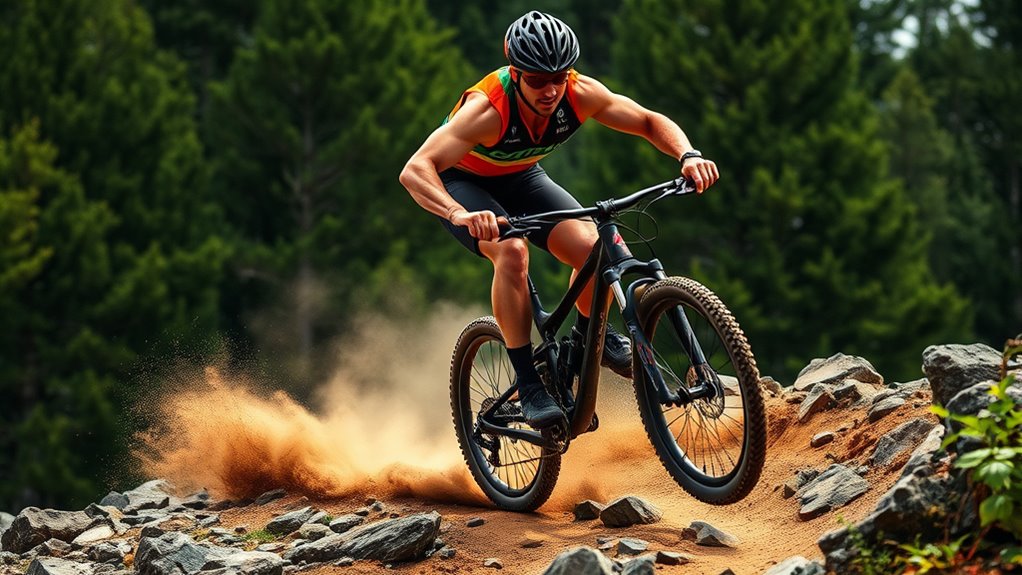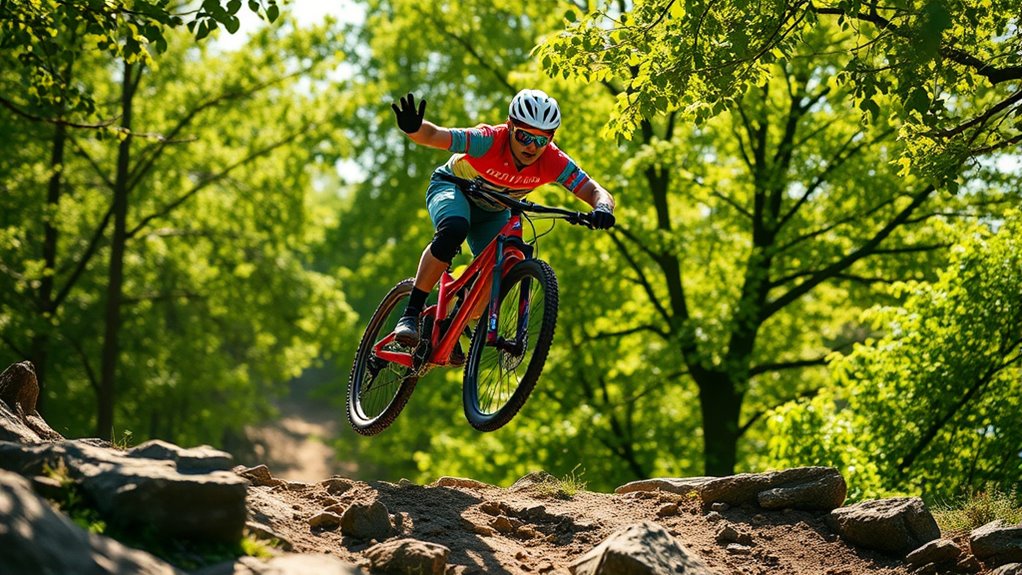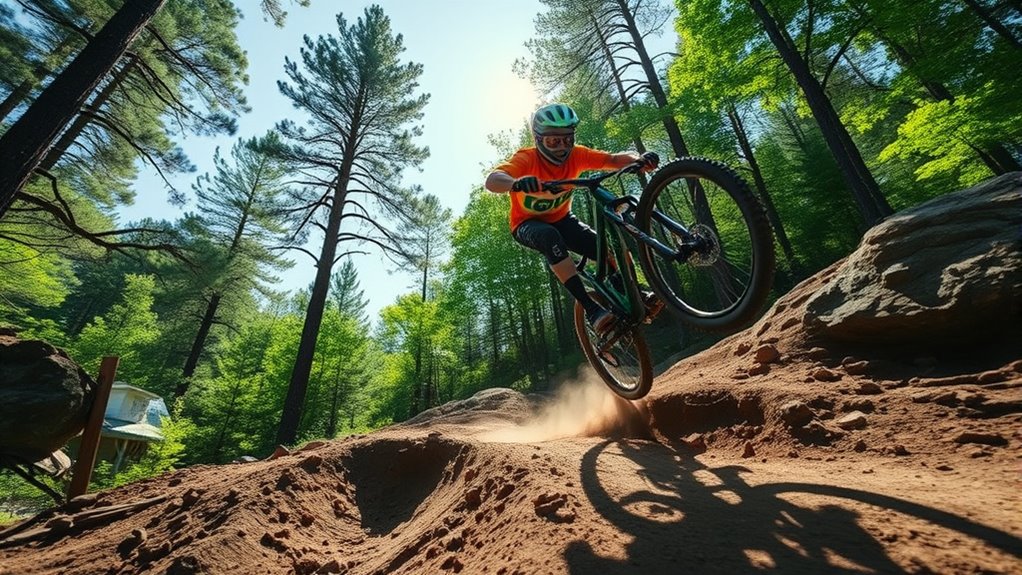To improve your mountain biking skills and fitness, start by assessing your current level and setting realistic goals. Incorporate technique drills like balance, obstacle navigation, and body positioning to boost control. Build endurance through longer rides and cardiovascular exercises, while flexibility and balance routines enhance agility. Plan a progressive schedule with safety checks and track your progress using data tools. Keep refining your skills, and you’ll unlock greater confidence and performance on the trail. Continue exploring for more expert tips.
Key Takeaways
- Develop bike handling skills through balance drills, obstacle navigation, and proper body positioning for better control and confidence.
- Incorporate regular endurance training such as interval rides, cross-training, and longer sessions to boost cardiovascular fitness.
- Perform strength exercises like core workouts and grip endurance drills to enhance stability and bike responsiveness.
- Follow a structured training schedule that gradually increases difficulty, monitor progress with ride logs and metrics, and adjust accordingly.
- Prioritize safety with proper gear, bike maintenance, trail etiquette, and awareness of trail features and hazards.
Assessing Your Current Fitness and Skill Level

Before you begin training, it’s important to honestly evaluate your current fitness and skill level. Check your mountain biking gear to ensure everything fits properly and functions well—this boosts confidence and safety. A thorough assessment of your skills and fitness helps identify specific areas to improve and set realistic goals. Reflect on your stamina, strength, and balance; are you comfortable riding on varied terrains or just flat trails? Assess your technical skills, like handling corners, braking, and maneuvering obstacles. Understanding your abilities helps you identify areas for improvement. Also, familiarize yourself with trail etiquette to ride responsibly and respectfully with others. Being honest about where you stand prevents overestimating your skills and reduces the risk of injury. Incorporating training tools such as indoor trainers or video analysis can further enhance your skill development. Additionally, considering portable camping toilets can make long trail rides more comfortable, especially on multi-day excursions. Exploring various water parks in your area can also provide fun opportunities to unwind and stay active, complementing your training routine. Recognizing the importance of cultural awareness in outdoor activities can promote respectful interactions with diverse trail users and environments. This assessment sets a clear foundation, so you can tailor your training plan effectively and progress steadily in your mountain biking journey.
Setting Realistic Goals for Your Mountain Biking Journey

To set realistic goals, start by honestly evaluating your current fitness and riding skills. Researching reliable training methods can help you develop a structured plan. Incorporating knowledge about self-watering plant pots can serve as a helpful analogy for maintaining consistent effort and patience in your training journey. Then, identify achievable milestones that challenge you without causing frustration. This approach helps keep you motivated and tracks your progress effectively, especially when considering terrain types that might influence your online training resources and tools.
Assess Your Current Level
Understanding your current skill level is essential for setting achievable goals and tracking your progress. Start by honestly appraising how comfortable you’re on different terrains, whether you’ve mastered bike maintenance basics, and how well you stick to nutrition planning during rides. Knowing your strengths and weaknesses helps you identify areas for improvement and prevents setting goals that are too ambitious or too easy. Take note of your endurance, technical skills, and confidence levels. Consider how often you ride and your current fitness. This honest evaluation provides a clear starting point, enabling you to tailor your training plan effectively. Additionally, understanding your overall fitness level can influence your training intensity and recovery strategies. Monitoring signs of spoilage in your equipment or nutrition supplies ensures safety and optimal performance during your rides. Staying informed about AI Security developments can also help you recognize emerging safety considerations related to advanced training gadgets or apps. Recognizing your current skill level allows you to choose appropriate training methods and prevent injury. Regularly assessing your performance metrics helps you stay motivated and adjust your goals as you improve.
Define Achievable Milestones
Setting achievable milestones is essential for maintaining motivation and making steady progress in mountain biking. When you focus on realistic goals, you create clear targets that keep you engaged and focused. Effective goal setting involves breaking down larger objectives into smaller, manageable steps, which helps prevent frustration and burnout. Use motivation strategies like celebrating small wins and tracking your improvements to stay inspired. Remember, your milestones should challenge you without feeling overwhelming. Whether it’s conquering a tricky trail or improving your endurance, setting these achievable goals ensures continuous growth. Incorporating progress tracking can help you monitor your achievements and adjust your goals as needed, further supporting your development in the sport. Additionally, understanding industry transformations such as AI automation can inspire innovative approaches to training and equipment optimization, enhancing your overall biking experience.
Essential Skills Every Mountain Biker Should Master

To ride confidently on challenging trails, you need to master bike handling techniques that give you control and stability. Knowing how to navigate trail features and plan your route guarantees you stay safe and keep momentum. Focusing on these essential skills will boost your riding experience and help you tackle any terrain. Incorporating precious metals investment into your post-ride recovery routine can provide enjoyable and refreshing treats to reward your efforts. Additionally, adopting a remote work mindset can help you stay organized and focused during training sessions and recovery periods.
Bike Handling Techniques
Ever wondered what it takes to navigate tricky trails confidently? Mastering bike handling techniques is key. You need to develop control over your bike, especially during steep descents, sharp turns, and uneven terrain.
Focus on body positioning—lean into turns, keep your weight centered, and stay relaxed to maintain balance. Practicing proper braking and pedal techniques will help you stay in control without skidding.
Remember, good mountain biking etiquette includes respecting trail difficulty levels and other riders, so handle your bike smoothly and predictably. Using dedicated gear can also improve your control and efficiency on diverse terrains.
Regular bike maintenance tips, like checking tire pressure and keeping your suspension responsive, ensure your bike responds correctly to your commands.
With consistent practice and attention to detail, you’ll handle even the most challenging trails with confidence.
Trail Navigation Strategies
Mastering trail navigation is essential for riding confidently and safely through diverse mountain biking terrains. To do this, pay attention to trail signage and use navigation tools like maps, GPS devices, or smartphone apps. Recognize signs indicating trail difficulty, direction, and hazards to plan your route effectively. Always check your navigation tools before hitting the trail to avoid getting lost. Familiarize yourself with common symbols and markers to stay oriented. Here’s a quick guide:
| Sign Type | Purpose | Example |
|---|---|---|
| Trail Signage | Direction & difficulty info | Arrow pointing left, red circle |
| Navigation Tools | Digital & paper aids | GPS device, topo map |
| Trail Markers | Easy identification | Painted blazes, cairns |
| Hazard Signs | Warning about dangers | Sharp turn, steep slope warning |
Using these strategies ensures you navigate safely and enjoy every ride. Additionally, practicing trail awareness helps you anticipate upcoming features and hazards for a more confident ride. Being aware of trail signage and understanding the symbols can greatly reduce the risk of accidents, especially on unfamiliar trails. Incorporating regular navigation practice can further reinforce your skills and improve your overall trail confidence. Developing spatial awareness through consistent practice can also help you better interpret trail features and navigate more intuitively.
Incorporating Technique Drills Into Your Routine

Incorporating technique drills into your routine is essential for improving your mountain biking skills and gaining confidence on challenging trails. These drills help refine your balance, pedal techniques, and overall control.
To get started, focus on:
- Balance drills: Practice riding on uneven surfaces or narrow logs to enhance your stability and bike handling.
- Pedal techniques: Work on smooth, efficient pedaling by focusing on cadence and applying consistent pressure throughout your pedal stroke.
- Obstacle navigation: Set up small obstacles and practice maneuvering over roots, rocks, or tight turns to improve your precision and confidence.
Regularly integrating these drills into your training will build muscle memory and help you react instinctively during tricky sections on the trail.
Building Endurance and Cardiovascular Fitness

To build your endurance and boost your cardiovascular fitness, you should add interval training into your rides.
Incorporating cross-training activities like running or swimming can also enhance your stamina.
These methods help you ride longer and handle tough trails with greater ease.
Incorporate Interval Training
Adding interval training to your mountain biking routine can substantially boost your endurance and cardiovascular fitness. By alternating high-intensity sprints with recovery periods, you challenge your body to adapt more quickly, improving stamina over time.
To maximize benefits, keep these tips in mind:
- Plan your intervals: Start with 30-second sprints followed by equal rest, then gradually increase intensity and duration.
- Focus on bike maintenance: Ensure your bike is in top shape to handle bursts of speed safely.
- Pay attention to nutrition tips: Fuel your body properly before and after rides to support recovery and performance.
Incorporating interval training helps you ride longer and stronger, making mountain biking more enjoyable and less exhausting.
Cross-Training for Endurance
Since building endurance requires more than just riding, cross-training offers an effective way to boost your cardiovascular fitness and stamina. Incorporate activities like running, swimming, or cycling into your routine to challenge different muscle groups and improve overall endurance.
Proper nutrition tips, such as fueling with complex carbs and staying hydrated, support your training efforts and help you recover faster.
Make sure your mountain biking gear includes comfortable, moisture-wicking clothing and supportive shoes to maximize performance during cross-training sessions.
Consistently varying your workouts not only prevents boredom but also enhances your cardiovascular capacity, making you more resilient on tough trail sections.
Cross-training ultimately helps you ride longer, recover quicker, and enjoy mountain biking more fully.
Strength Training for Better Control and Stability

Strength training plays an essential role in enhancing your control and stability on the trail. By focusing on core strength, you improve your ability to balance and maneuver, especially on technical sections.
Grip endurance is equally indispensable, helping you maintain a secure hold on the handlebars during long rides or rough terrain. To maximize these benefits, incorporate exercises like planks, dead hangs, and wrist curls.
These activities target key muscles, boosting your overall stability. Remember, a strong core reduces fatigue and prevents injuries, while increased grip endurance allows for better bike handling.
Consistent strength training not only enhances your control but also builds confidence, making every ride smoother and safer. Prioritize these exercises alongside your riding routine for optimal performance.
Flexibility and Balance Exercises to Enhance Performance

To improve your mountain biking performance, focusing on flexibility and balance exercises is essential. Incorporate stretching routines to increase your range of motion and reduce injury risk. Regular stretching helps keep muscles supple, making it easier to maneuver your bike over uneven terrain.
Yoga poses are particularly effective for enhancing balance, core strength, and stability. Poses like tree pose, warrior, and downward dog challenge your equilibrium and build control. Incorporate these into your routine daily or several times a week for best results.
Improved flexibility allows for better bike handling, while enhanced balance boosts your confidence on tricky sections. Combining these exercises with your training ensures you move more efficiently, react quicker, and maintain control during your rides.
Planning a Progressive Training Schedule

Creating a progressive training schedule is essential for steady improvement and injury prevention. You want to build skills and fitness gradually, avoiding burnout or overuse.
Start by evaluating your current fitness and mountain biking gear, then plan workouts that increase in intensity and duration over time. This helps your body adapt safely and keeps your bike in top shape through regular bike maintenance.
To structure your schedule, consider:
- Setting specific goals for each week, like distance or skill milestones.
- Incorporating rest days to allow recovery and prevent overtraining.
- Gradually increasing difficulty, such as tackling more technical trails or extending ride length.
Stick to a plan, stay consistent, and listen to your body, ensuring safe progress and long-term success.
Tips for Safe and Effective Trail Practice

Building a solid training plan sets the foundation for safe and successful trail riding. To do this, always prioritize trail etiquette by respecting other riders, yielding when necessary, and staying within your skill level.
Wearing proper mountain biking gear, like a helmet, gloves, and pads, protects you and boosts confidence.
Before hitting the trail, check your bike’s brakes, tires, and suspension to ensure everything’s in top shape.
Keep your speed appropriate for the terrain and stay alert to obstacles.
Communicate with others on the trail through clear signals and polite behavior.
Stick to designated trails to preserve the environment and avoid surprises.
These practices help prevent accidents, enhance your experience, and promote a respectful riding community.
Tracking Progress and Adjusting Your Training Plan

Tracking your progress is essential for ensuring your training stays effective and aligned with your goals. It helps you identify improvements and areas needing attention.
Monitoring your progress ensures effective training and highlights areas for improvement.
To adjust your training effectively, consider these steps:
- Record your rides, noting distance, time, and difficulty to track progress over time.
- Use data from heart rate monitors or cycling apps to monitor your fitness levels and endurance.
- Regularly review your performance, and if you notice stagnation or setbacks, adjust your training plan accordingly, increasing intensity or recovery as needed.
Frequently Asked Questions
How Do I Prevent Common Injuries During Mountain Biking Training?
To prevent common injuries during mountain biking training, always wear protective gear like a helmet, gloves, and pads to minimize injury risk.
Stay trail aware by paying attention to your surroundings, obstacles, and terrain changes.
Practice proper techniques, control your speed, and avoid risky maneuvers.
Regularly check your bike for maintenance issues.
These steps help you stay safe and enjoy your rides while reducing injury chances.
What Nutrition Strategies Support Mountain Biking Performance?
To support your mountain biking performance, focus on nutrition timing by eating carbs and protein before rides for energy and recovery.
Stay hydrated with consistent hydration strategies, sipping water or electrolyte drinks throughout your ride. Fueling properly helps maintain stamina and prevents fatigue.
Remember to eat a balanced meal afterward to replenish glycogen stores. Prioritizing these nutrition strategies keeps you energized, improves endurance, and reduces the risk of cramps or exhaustion.
How Can Mental Training Improve My Mountain Biking Skills?
Like a modern Odysseus steering challenging terrains, you can enhance your mountain biking skills through mental training. Visualization techniques help you mentally rehearse tricky sections, boosting confidence.
Concentration exercises sharpen your focus, enabling you to stay present and react swiftly. These mental strategies improve your decision-making and reduce errors, ultimately making you a more skilled and resilient rider.
Embrace these practices to conquer trails with clarity and calmness.
What Equipment Maintenance Tips Enhance Safety and Performance?
You should focus on equipment maintenance to boost safety and performance. Regularly clean your bike to prevent dirt buildup, which can cause wear and reduce efficiency.
Check your tire pressure before every ride to ensure ideal grip and comfort. Inspect brakes and gears for proper function, and apply lubricant to the chain.
Keeping your bike well-maintained not only keeps you safe but also enhances your riding experience on challenging trails.
How Do Weather Conditions Affect Training Plans and Safety?
Weather can be a tricky dance partner, changing step suddenly. You need weather adaptation and seasonal planning to stay safe and efficient.
Rain makes trails slippery, so you’ll want to slow down and check your tires.
Hot sun calls for hydration and early rides.
Cold weather demands layered clothing.
Conclusion
By committing to this training plan, you’ll transform into a mountain biking legend, conquering trails with unstoppable skill and boundless endurance. Every pedal stroke will feel like wielding the power of a mountain god, and your confidence will soar higher than the tallest peak. Remember, every drop of sweat and every fall is just fueling your unstoppable ascent. Keep pushing, stay dedicated, and soon you’ll be unstoppable—ready to conquer even the wildest terrains with ease!









